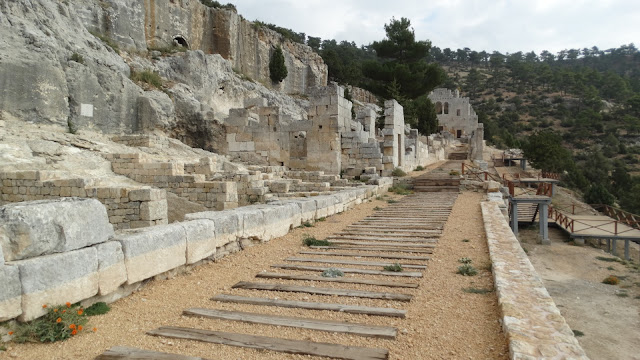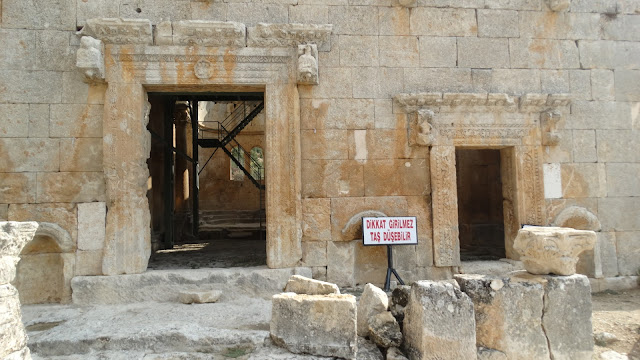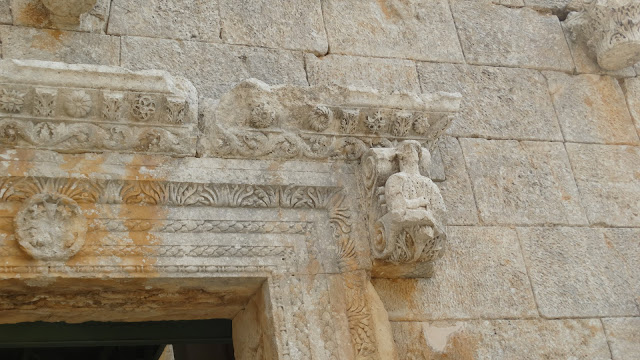8th century B.C. Neo-Hittite wall carving at Ivrez
Cliff_Emerson©
After leaving the mound-remains of the city of Derbe in south-central Turkey (Primary reference: Book of Acts 14:19-20), the next destination for my rental car field-trip was a site about 1 hour toward the east, at Ivrez - this remarkable Hittite wall carving.GEO (French version)
I used this map on my trip and highlighted the route with an orange marker.
At the time of my arrival in this part of Turkey on this trip:
I landed at Nevşehir airport from Istanbul and drove my rental car in a counter-clockwise direction on the orange route - to the cities I marked in red, beginning with Konya (formerly Iconium in the New Testament).
On this trip I spent a great deal of my time seeking-out rather obscure touristic sites that were off the beaten path - the kind that relatively few people ever see, even if they went on special tour groups in busses. This approach required a lot of time, effort and focused energy to reach. (see: Visit to Alahan LINK)
I had no navigator, no companion, no GPS in the car, and no Turkish-issued road maps, so I had to bring printed screen shots of the vicinity from Google Maps and a map (above) from the French GEO magazine.
After getting back to the east-west road between Karaman – Nigde – Nevsehir - (see orange route on map, above), I proceeded east on the main highway (D-350) and then turned south at Ereğli driving 25 minutes to reach the village of Ivrez.
This video; leaving Derbe and heading toward east toward Ereğli.Google Maps screen shot.
Above, the city of Ereğli and surroundings. I had to use this printed screenshot and road signs to find the right road to the south. Above, a second screen shot shows the site of the carvings was near a reservoir south-east of Ereğli.
The video below was taken for fun to document the music entertainment on the trip to Ivrez - as well as the route and countryside. I often bring along CD's to play while driving, in this case Elton John's "Empty Sky" album. It's good to get crazy once in a while!
The village of Ivrez is located 3 km. south of the town of Halkapinar, on a small mountain range called Bolkardaglari, on the northern slopes of the Taurus Mountain range.
Fortunately, this carving miraculously survived many centuries of exposure to foreign religions, weather, local inhabitants and possibly warring troops. I immediately had the impression that originally a small river ran in front of it and protected it physically from people who could damage it.
Site Description:
Apparently, there was also a small Neo-Hittite altar nearby, and a Christian monastery during the Middle Byzantine Period, but these were not the main attraction. The Ivrez site's main focus was this in situ (in original place) Neo-Hittite rock relief, located in a park. It was just captivating!
Cliff_Emerson©
Looking toward the carving, which is located behind the three people standing at the railing in front of the rock abutment. Compare this view with the picture below. You can most easily see the deity's legs and skirt. The carving is huge!
Cliff_Emerson©
Description: The two characters - A Deity and a King
The composition is surprisingly large - approximately 4.2 m. (13.8 feet) tall and 2.40 m. (7.9 feet) wide. It is carved on a rock outcrop facing north in a hillside.
The Luwian weather god Tarhunzas, faces the king Warpalawas of Tuwanuwa, on the right side who is shown in a posture of servitude. Both are identified through the three inscriptions on the relief:
- One, in front of the head of the weather god - in a prominent position,
- Second, behind the king on the right side, and
- Third, at the bottom located in a small cavity, where a dedication to the artist is located. I haven't been able to locate this one.
On the left side, the weather god / deity holds a wheat bundle with his left hand and grapes with the other. He also carries grapes and grape leaves on his belt, which symbolize the fertility of the valley.
Tarhunzas, the deity, has a beard and curly hair, a typical symbol for Hittite deities. His hair and beard are depicted in the Assyrian or Aramaean style, found in many carvings from the Mesopotamian region.
Warpalawas is standing facing Tarhunzas; he is depicted smaller than the deity and is holding up both hands. He wears a round decorated hat and a long embroidered robe which is attached with a fibula. His hair and beard are made in the same style as the deity.
He is covered with some type of white-colored mineral precipitate that comes out of the rock above his head - causing the discoloration.
Background:
Here's a brief synopsis of the site's history:
- Late Bronze Age (1650-1200 BC), frontier marker, and religious and cultic site
- Iron Age (1200-650 BC)
- Middle-Late Byzantine period (843-1543 AD).
The site is mentioned in writings in the Late Bronze Age by the Hittites, and later in the Iron Age when it served as an important water cult sanctuary, and was carved in the 8th century BC.
Cliff_Emerson©
As mentioned earlier, originally there was water flowing in front of this relief work, protecting it from being defaced.
Cliff_Emerson©
Above, note the language inscription in front of the god's face. (How would you like to learn to speak and write this language?)
Cliff_Emerson©
Inscriptions are also found on the right side of the king's skirt, above.
The water in the springs was highly esteemed by the Hittites, who referred to it in a written treaty as marking the frontiers of two empires, that of the Hatti (a tribe of the Hittites) and the Tarhuntassa.
Here's what Wikipedia says about them:
Tarḫuntašša (Hittite: 𒀭𒅎𒋫𒀸𒊭 dIM-ta-aš-ša "City of Tarhunt"; Hieroglyphic Luwian: (DEUS)TONITRUS-hu-ta-sá) was a Hittite Bronze Age city in Asia Minor mentioned in Hittite documents. Its location is still unknown; in 2019, a previously little-researched site at Türkmen-Karahöyük, near Çumra on the Konya Plain - to the NW - was located.
https://en.wikipedia.org/wiki/Tar%E1%B8%ABunta%C5%A1%C5%A1a
In the 8th century BC Warpalawas of Tuwanuwa, the king who was depicted in the carving, commissioned the work to be carved on this site. Nice homage to himself, huh... getting some face-to-face time with his own god!
Below, a close-up of the deity:
Cliff_Emerson©
If your browser and monitor allow, you might be able to scroll this photo vertically and horizontally!
The carving represents the deity bestowing strength upon the king, and the blessing of fertility - symbolized by the grapes. Even today, the Halkapınar and Ereğli regions are still famous for growing grapes.
https://whc.unesco.org/en/tentativelists/6244/
Click here to return to the Blog's Table of Contents
++++++
Hittite Figures
Let's now focus on a different kind of Hittite artwork.
I love the variety of shapes and figures represented in Hittite artifacts found at specific sites in Turkey, now in museums.
 Klaus-Peter Simon - https://commons.wikimedia.org/w/index.php?curid=32511457
Klaus-Peter Simon - https://commons.wikimedia.org/w/index.php?curid=32511457
Above, bronze figures of deer in the Museum of Anatolian Civilizations, Ankara, Turkey
Klaus-Peter Simon: https://creativecommons.org/licenses/by-sa/3.0
The sun disk above, was one of the Alaca Höyük bronze standards from an early-Hittite tomb dating to the third millennium BC, from the Museum of Anatolian Civilizations, Ankara.
Georges Jansoone (JoJan): http://creativecommons.org/licenses/by-sa/3.0/
The Stag statuette, symbol of a Hittite male god, in Museum of Anatolian Civilizations, Ankara.
I also bought a wonderful copy (similar in appearance) in bronze when I was in Boğacale and Yazilikkala, Turkey, along with some decorative stone carvings, which I'll show you in a later post.
Klaus-Peter Simon - https://creativecommons.org/licenses/by-sa/3.0
Alaca Höyük bronze standard deer with a nose made from gold, and two lions/panthers in the Museum of Anatolian Civilizations, Ankara.
One of the exciting rewards of studying the history and culture of the Hittites is observe their outstanding artwork.
Their carvings in stone are exceptional.
https://en.wikipedia.org/wiki/Nev%C5%9Fehir_Province#/media/File:Nev%C5%9Fehir_in_Turkey.svg
In an upcoming website, I will show you some things I saw on this trip to Hattusha, the former capital of the Hittite Empire (1300-1200), located about 70 km. east of Turkey's capital city, Ankara.
Nevşehir, one of the major cities of Cappadocia, displays a unique and beautiful combination of nature and history. Most famous are the "fairy chimneys" made of volcanic tuft. The Hittites lived in this area, but no remains of them have been found.https://www.turkishairlines.com/de-at/flights/flights-to-nevsehir/
(Depending on your browser and monitor, the picture above should scroll horizontally and vertically, so use your mouse on the scroll bars, if possible.)
Volcanic activity produced the "fairy chimney" geologic formations. Christians who lived in these regions carved houses and churches into the tuft walls, some adorned with religious motives on the walls as frescoes. Due to the location of some of these caves - underground or high on vertical walls - it is evident that they were fleeing from their pursuers. (More in an upcoming blog.)
As you can see from the map below, the province of Cappedocia is located in the center of modern Turkey. During ancient times, this area was part of the Hittite Empire.
The entire area saw the disappearance of an earlier dominant Hittite civilization after 1000 B.C. due to the raids of the "sea peoples." Not much is known about these ferocious warriors. Later, in the 6th century A.D., their culture was progressively destroyed by raids from sea-faring Arabs who had worked with the Phoenicians and other Mediterranean peoples to launch raids on the sea.
https://www.ancient.eu/image/1071/hittite-empire-c-1300-bce/
The Hittite Kingdom once bordered the Egyptian Kingdom. An important stelle (standing rock monument) has been found at the site where the two parties fought and established a peace accord, now located in Istanbul's Archeological Museum. A copy of it is at the UN Building in New York City. See it on a previous post. LINK
I just located an excellent map for travel in Turkey; Ivrez is southeast of Ereğli, southwest of Halkapinar.
http://ontheworldmap.com/turkey/large-detailed-road-map-of-turkey.jpg
Click here to return to the Blog's Table of Contents













































































